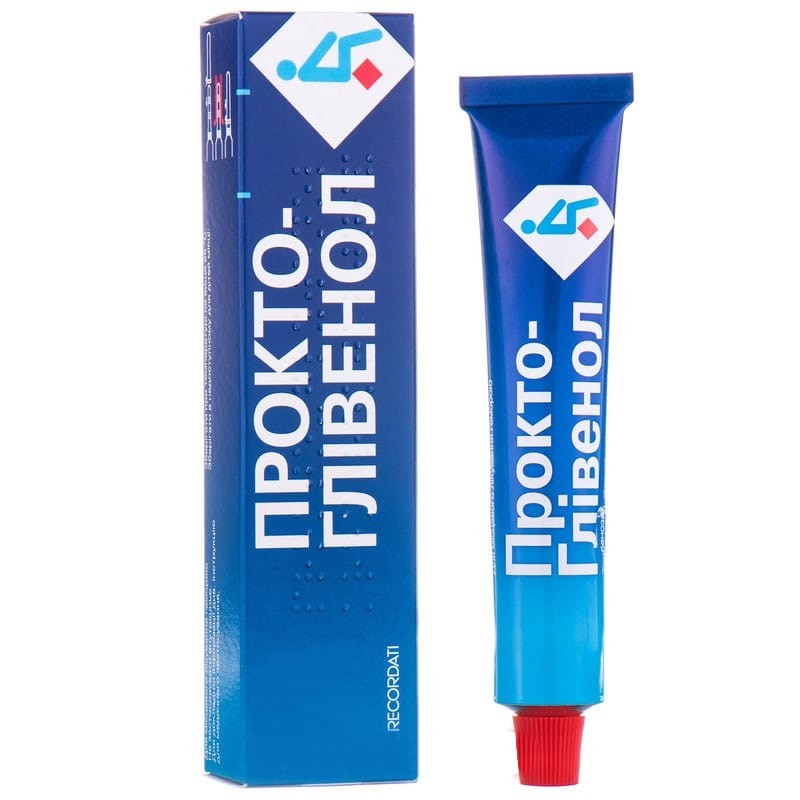



 Secure and encrypted payment processing
Secure and encrypted payment processing We ship to over 40 countries including the USA, UK, Europe, Australia and Japan
We ship to over 40 countries including the USA, UK, Europe, Australia and Japan Guaranteed refund or reship if you haven't received your order
Guaranteed refund or reship if you haven't received your orderPharmacodynamic parameters. Procto-glyvenol combines the rapid local anesthetic effect exerted by lidocaine with the effectiveness of tribenoside in promoting local healing and restoration of normal state and vascular function.
Derived glucofuranoside tribenoside has a powerful anti-inflammatory effect, has an antagonistic effect against histamine, serotonin, bradykinin and other inflammatory mediators. Tribenoside counteracts pathological processes in the capillary and venous wall; improves vascular tone and reduces capillary permeability, thereby reducing swelling; regulates the expression and localization of laminins, contributing to the restoration of the basement membrane and providing a wound healing effect. Tribenoside has no inherent adverse systemic effects inherent to corticosteroids and NSAIDs.
Synthetic aminoethylamide lidocaine stabilizes the membrane of neurons by inhibiting voltage-gated sodium channels and, accordingly, the ion flux necessary for initiating and conducting pulses. Lidocaine is characterized by the rapid (within a few minutes) development of a superficial anesthetic effect, providing rapid relief of pain and itching.
The combined mechanism of action of Procto-glyvenol allows you to control both subjective (including pain and discomfort) and objective (including prolapse and bleeding) symptoms of hemorrhoids, reducing the manifestations of the inflammatory process and increasing vascular tone.
Pharmacokinetic parameters. Procto-glyvenol has a topical effect with negligible systemic activity.
The bioavailability of tribenoside when administered per rectum is 30%. The therapeutic concentration with the indicated route of administration is achieved exclusively locally with a slight entry into the systemic circulation. With the introduction of 1 dose of cream for application (or 1 suppository) Cmax in blood plasma - 1 μg / ml - is achieved after 2 hours.
Tribenoside undergoes rapid metabolism, 20–27% is excreted in the urine as metabolites.
Lidocaine is rapidly absorbed from the mucous membrane (absorption through the skin with intact integrity is negligible). With the introduction of per rectum bioavailability is about 50%. Cmax in the blood plasma lidocaine (0.70 μg / ml) after administration of 300 mg of the substance (1 suppository) is achieved after 112 minutes.
Lidocaine also undergoes rapid metabolism in the liver, 10% of the unchanged dose is excreted in the urine.
Hemorrhoids (external and internal) - topical therapy.
Per rectum 2 times a day in the morning and evening, 1 suppository (1 cream application). after relief of acute manifestations, 1 suppository is used (1 cream application) per day. the duration of therapy depends on the severity of the manifestations of the disease and is determined by the doctor.
The introduction of a cream for the treatment of internal hemorrhoidal nodes is carried out using the nozzle in the package. Before each use of the nozzle, which is screwed onto the tube, the tread cap must be removed.
1 tube contains 30 g of cream, which is enough for 20-30 applications.
Hypersensitivity to any of the components of the drug (for example, local amide anesthetics).
Due to the rapid absorption of lidocaine through the mucous membrane, systemic effects are likely.
With caution, they are used in case of a pronounced violation in the patient of the function of the heart, liver and kidneys.
Due to the presence of cetyl alcohol in the cream, the development of local skin reactions is likely (among them - contact dermatitis). Propyl parahydroxybenzoate and methyl parahydroxybenzoate can also cause delayed allergic reactions.
The latex rubber that makes up the nozzle can cause allergic reactions.
In the absence of positive dynamics within 1 week (or when any new symptoms appear), a doctors consultation is necessary to exclude other probable causes.
It is necessary to observe the hygiene of the anus, a mobile lifestyle and a diet that provides a soft consistency of the stool.
Oral administration of the drug or its contact with the eyes is not allowed.
Do not use in the first trimester of pregnancy. In the II – III trimester and period of breastfeeding, the use of the drug is allowed provided that the indicated dosage is followed and taking into account the likely risks for the mother and child’s body.
In childhood, do not use.
The impact on the reaction rate when driving vehicles or other mechanisms is negligible or absent.
In connection with the presence of lidocaine, it is used with caution in combination with antiarrhythmic membrane-stabilizing agents or other means for local anesthesia due to the likely possibility of the development of a combined systemic effect. amplification of the topical analgesic effect of lidocaine occurs when combined with MAO inhibitors.
No information available. in case of unintentional oral administration, immediate gastric lavage is required. symptomatic therapy with general supportive measures.
In a place inaccessible to children, suppositories - at a temperature of ≤30 ° C, cream - at a temperature of ≤25 ° C.